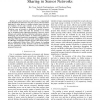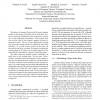54 search results - page 10 / 11 » Collaborative Attack Detection in High-Speed Networks |
SSS
2007
Springer
14 years 2 months ago
2007
Springer
We consider Cooperative Intrusion Detection System (CIDS) which is a distributed AIS-based (Artificial Immune System) IDS where nodes collaborate over a peer-to-peer overlay netwo...
NDSS
2008
IEEE
14 years 2 months ago
2008
IEEE
Third Generation (3G) cellular networks utilize timevarying and location-dependent channel conditions to provide broadband services. They employ opportunistic scheduling to effic...
SECON
2008
IEEE
14 years 2 months ago
2008
IEEE
—In sensor networks, an intruder (i.e., compromised node) identified and isolated in one place can be relocated and/or duplicated to other places to continue attacks; hence, det...
WPES
2006
ACM
14 years 2 months ago
2006
ACM
Recent trends in Internet computing have led to the popularization of many forms of virtual organizations. Examples include supply chain management, grid computing, and collaborat...
SP
2008
IEEE
14 years 2 months ago
2008
IEEE
The efficacy of Anomaly Detection (AD) sensors depends heavily on the quality of the data used to train them. Artificial or contrived training data may not provide a realistic v...


